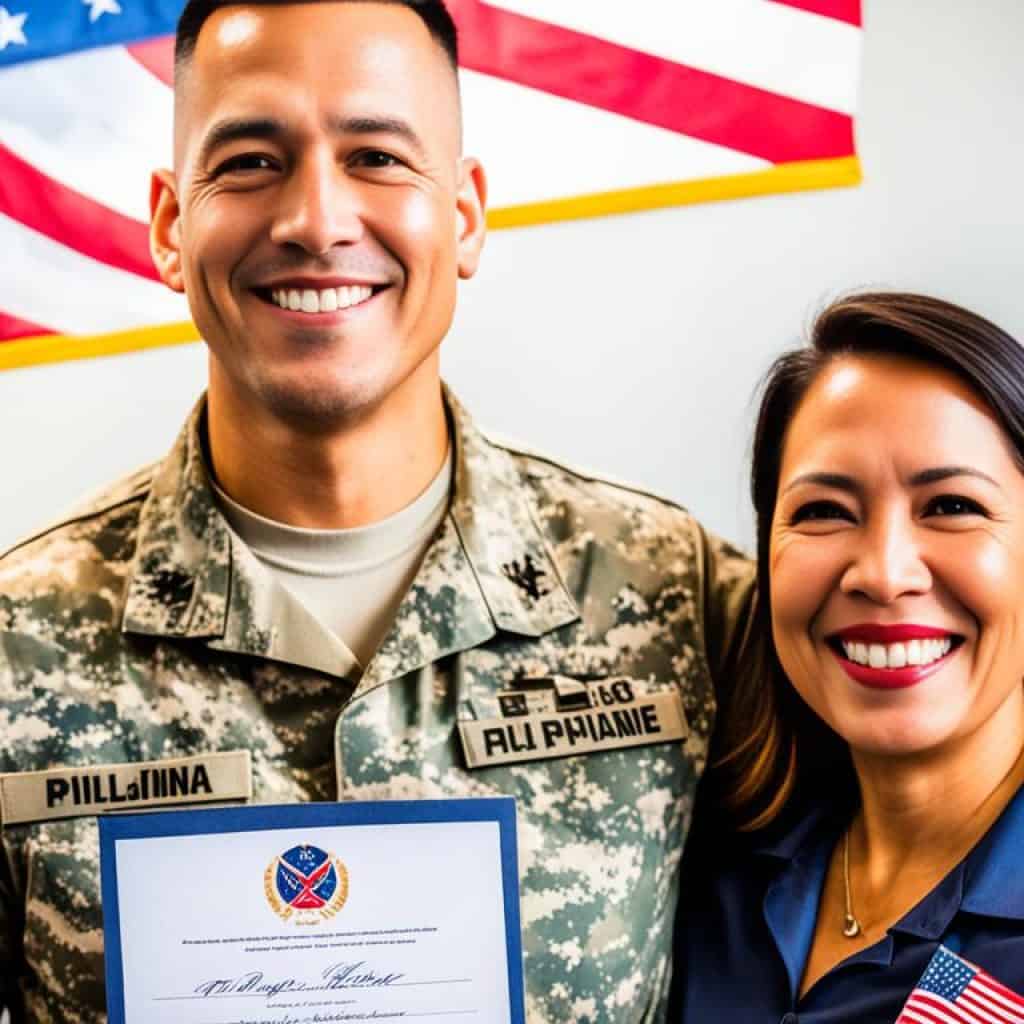Are you curious if your marriage in the Philippines will be accepted in the United States? Many couples ask this because dealing with international marriage laws can be tricky1. Luckily, Article 26 of the Philippines’ Family Code says marriages done outside the country are okay in the Philippines1. But, what does the U.S. government think about these marriages? Let’s look into the main points.
Key Takeaways
- Marriages in the Philippines are usually seen as valid in the U.S., thanks to the lex loci celebrationis rule.
- The U.S. needs certain documents and steps to accept Philippine marriages for immigration.
- If you were divorced in the Philippines, you might need more proof to show it was valid in the U.S.
- Polygamous marriages aren’t accepted by U.S. immigration laws and could stop you from entering the country.
- It’s important to talk to an immigration lawyer who knows about international marriage laws.
Legality of Filipino Marriages in the United States
The U.S. government says Filipino marriages are legal if they are valid and recognized where they happened2. This means if you got a divorce in the Philippines and it’s valid there, it counts in the U.S. for immigration.
Foreign marriages are usually okay in the U.S. if they are legal in the country where they happened3. This is true for marriages between U.S. citizens and Filipinos, or between two foreign nationals. Just make sure the marriage was done legally in that country.
Recognition of Divorces for Immigration Purposes
U.S. immigration law says if a divorce is valid and recognized where it was given, it counts for immigration4. So, if you get a U.S. divorce, USCIS will recognize it. This means you could marry your Filipino partner after that. But, some divorces from abroad might not be recognized if they didn’t involve both parties in court.
Validity of Foreign Marriages in the U.S.
Foreign marriages are usually valid in the U.S. if they are legal where they happened3. This covers marriages between U.S. citizens and foreign nationals, or between two foreign nationals. The important thing is the marriage was done legally in that country.
The U.S. government is very serious about the legality of marriages and divorces for immigration. Couples need to show proof their marriage is legal. Sometimes, they might need more documents or legal steps to get their marriage recognized by U.S. authorities324.
Marrying a Filipino Citizen in the Philippines
If you’re a U.S. citizen wanting to marry a Filipino, you must do it in the Philippines. You’ll need to get legal papers and register the marriage with the Philippine government. Knowing what you need makes the process easier.
Certificate of Legal Capacity to Contract Marriage
First, get a “Certificate of Legal Capacity to Contract Marriage” from the U.S. Embassy or Consulate5. This proves you’re free to marry and not already tied to someone else. The Philippine government needs it before giving you a marriage license.
Obtaining a Marriage License in the Philippines
With the Certificate in hand, you and your partner must apply for a marriage license6. There’s a 10-day wait after you apply. You might also need to take pre-marital counseling classes during this time.
Registering the Marriage in the Philippines
After the wedding, register your marriage with the Philippine Statistics Authority (PSA)6. You’ll get a PSA Marriage Certificate, proving your marriage is legal. It takes 6 to 12 months to get this certificate after reporting the marriage7.
Knowing the steps and what you need helps U.S. citizens marry a Filipino in the Philippines6. The process includes beautiful wedding spots, legal steps, and the final marriage registration. It makes the experience special for couples.
Bringing a Filipino Spouse to the U.S. on an Immigrant Visa
If you’re a U.S. citizen and want to bring your Filipino spouse here, they’ll need an IR-1 / CR-1 Spousal Immigrant Visa8. First, you file the I-130 Petition. Then, you wait for USCIS approval, go through NVC processing, and have a consular interview9.
Start by filing the I-130, Petition for Alien Relative, with USCIS. You’ll need to include your marriage certificate, any divorce papers, and passport-style photos9. While waiting, your spouse might get a nonimmigrant K-3 visa to visit the U.S. temporarily9.
After the I-130 gets approved, the case goes to the National Visa Center (NVC) for more processing. They’ll ask for more documents and fees before your spouse can have their visa interview at the U.S. Embassy in Manila9.
At the consular interview, a consular officer checks the petition and documents. They decide if your spouse can get the immigrant visa9. If yes, they get an immigrant visa to come to the U.S. and apply for a “green card”9.
The whole process can take months to over a year, depending on how fast things move9. Getting help from a licensed immigration lawyer or an accredited nonprofit can make things smoother and increase your chances of success10.
| Step | Description |
|---|---|
| I-130 Petition | File I-130 Petition for Alien Relative with USCIS |
| NVC Processing | Petition approved, case transferred to National Visa Center |
| Consular Interview | Attend visa interview at U.S. Embassy in Manila |
| Visa Issuance | Immigrant visa issued if approved, travel to the U.S. |
Knowing the steps to bring a Filipino spouse to the U.S. on an immigrant visa helps you navigate the process better. This way, you can make sure it goes well for your family8910.
Steps in the Marriage-Based Immigration Process
If you’re married to someone in the U.S., you can apply for a green card through marriage. This process has several steps, each with its own rules and timeframes. Let’s look at the steps you’ll need to follow.
Petition to Recognize the Relationship
The first step is to file the I-130 Petition for Alien Relative with the U.S. Citizenship and Immigration Services (USCIS). This petition proves your marriage is real11. It usually takes 7 to 10 months to process and costs $53512.
Waiting Period for Petition Approval
After filing the I-130 petition, you wait for USCIS to approve it. The time you wait depends on your spouse’s immigration status. If your spouse is a U.S. citizen, you don’t have to wait. But if they’re a green card holder, you’ll wait about 2 weeks1112.
NVC Processing for Visa Application
Once the I-130 petition is approved, your case goes to the National Visa Center (NVC). Here, you’ll pay fees, fill out the DS-260 application, and upload documents12. You’ll need to pay about $445 in government fees for an immigrant visa12.
The marriage-based immigration process is complex and takes time. It’s crucial to stay organized and follow instructions closely. If you’re unsure, consider getting professional help to make the process smoother111312.
Required Documents for a Filipino Spouse’s Immigration
When you sponsor a Filipino spouse for U.S. immigration, you need to provide several important documents14. Your spouse will need three documents from the Philippines: a PSA Birth Certificate, PSA Advisory on Marriage, and NBI Police Clearance14.
These documents are needed during NVC processing and the U.S. Embassy interview in Manila14. The U.S. Embassy in Manila or the U.S. Consulate in Cebu charges a $50 fee (or its Philippine Peso equivalent) for Legal Capacity to Marry appointments14. Also, Philippine law requires a ten-day wait for a marriage license14.
The IR-1/CR-1 Spousal Immigrant Visa process takes about 18 to 24 months14. But, you might get Expedited Processing, which takes 6-8 months14. The total cost for immigration is $1305 as of April 1, 202414.
Immigration processing usually takes 18 to 24 months14. With Expedited Processing, it can be faster, taking 6-8 months14. The Manila Embassy gives instructions for the Consular Interview14.
Remember, the documents needed and processing times can change. It’s key to keep up with the latest from the U.S. Embassy and USCIS.
“The key to a successful Filipino spouse immigration is having all the required documents ready and submitting them in a timely manner.”
| Document | Description |
|---|---|
| PSA Birth Certificate | An official birth certificate issued by the Philippine Statistics Authority (PSA). |
| PSA Advisory on Marriage | A document from the PSA that provides information about the marriage requirements in the Philippines. |
| NBI Police Clearance | A clearance certificate issued by the National Bureau of Investigation (NBI) in the Philippines, which confirms the applicant’s criminal record (or lack thereof). |
These documents are needed during NVC processing and at the U.S. Embassy interview in Manila14. Making sure you have all the documents in order can make the immigration process smoother for your Filipino spouse3.
Applying for a U.S. green card through marriage has many steps, like filling out forms, going to interviews, and showing proof of a real marriage3. Issues can come up if spouses didn’t go through inspection, used fake visas, or if the sponsor is a permanent resident, not a citizen3.
Knowing what documents you need and the immigration process can help you prepare for a successful Filipino spouse immigration15. Over 600,000 Filipinos move to the U.S. every year, and the USCIS Manila office handles immigration for many Pacific nations15.
Costs and Processing Times for Filipino Spouse Immigration
The cost for Filipino spouse immigration to the United States is about $1,30516. The wait time is usually 18 to 24 months16. But, U.S. citizens can get their spouse’s visa faster, in 6 to 8 months16.
The wait time can change based on the visa type and conditions16. The total cost also includes medical exams, legal help, and travel costs for both the petitioner and the spouse17.
| Expense | Cost |
|---|---|
| USCIS Filing Fee | $53517 |
| Embassy Fee | $26517 |
| Medical Exam | $60 to $30017 |
| Legal Assistance | $1,800 to $3,00017 |
It’s important to budget well for the Filipino spouse immigration process1617. Getting professional help can make it smoother and more successful18.
The U.S. Embassy in Manila offers expedited appointments for emergencies18. But, there are longer wait times for nonimmigrant visas now18.
The costs and wait times for Filipino spouse immigration can change. It’s key to plan well and get professional advice to succeed161718.
Consular Interview for a Filipino Spouse’s Immigrant Visa
Getting a U.S. immigrant visa as a Filipino spouse is a big step in moving to the U.S. The U.S. Embassy in Manila gives clear instructions for the consular interview. This is a key part of getting the visa19.
Interview Instructions from the U.S. Embassy in Manila
At the consular interview, the Filipino spouse must bring important documents. These include the Philippine Statistics Authority (PSA) Birth Certificate, PSA Advisory on Marriage, and National Bureau of Investigation (NBI) Police Clearance19. If they lived in the Philippines for a year or more after turning 16, they also need a police certificate from their current country19. The NBI Clearance must include all names the applicant has used19.
Depending on the visa type, more documents might be needed. For family visas, the Form I-864 Affidavit of Support and proof of the U.S. petitioner’s status are required19. If the applicant is single and 18 or older, they need a Certificate of No Marriage (CENOMAR) from the Philippine Statistics Authority19. Married applicants must bring their original marriage certificate and an English translation19. Those with previous marriages need to provide proof of their divorce or annulment19.
For work visas, a job offer letter with a salary at or above the local prevailing wage is needed19. Certain visas require specific certifications, like Nursing or Physical Therapy licenses19.
Before the interview, the Filipino spouse must get a medical check-up at the St. Luke’s Medical Center Extension Clinic in Manila19. They should bring their passport, visa interview letter, photos, vaccination records, and DS-260 confirmation page19. The clinic charges for the medical exam19. The exam covers medical history, a physical check-up, chest X-ray, and blood tests19. TB testing is needed for those over two years old19. The exam also checks for U.S. vaccination requirements19.
The interview at the U.S. Embassy in Manila usually takes about 15 minutes for U.S. citizens petitioning their spouses from the Philippines20. After passing the interview, applicants might wait a few weeks for their visa20. During this time, a temporary stamp in their passport proves they have legal permanent residence20.
The consular interview and getting a visa is a big step for Filipino spouses wanting to join their U.S. partners. Knowing what documents are needed and the Embassy’s instructions helps applicants prepare for this important step in their immigration journey21.
Marriage in Philippines Legal in US?
If you plan to marry a Filipino citizen in the Philippines, you’ll find that the US accepts these marriages for immigration. The fee for registering the marriage at the Philippine Embassy or Consulate General in the US is $25.0022. You’ll need four original copies of the Report of Marriage Contracted Abroad form and other documents22.
Remember, the marriage must be for real love, not just for immigration benefits23. The Hague Apostille Convention of 1961 makes it easier to get your Philippine marriage recognized in the US23.
When you marry in the Philippines, you’ll need a marriage license and a Certificate of Legal Capacity to Contract Marriage (LCCM) from the Philippine Consulate24. The marriage license costs $25.00, and the ceremony is $60.0024. You’ll also need a Certificate of Non-Availability of Record of Marriage (CENOMAR) and other documents24.
As long as your marriage in the Philippines is legal, it’s valid in the US for sponsoring your spouse for a green card. You’ll need to do some paperwork and pay some fees, but with the right help, you can bring your Filipino spouse to the US.

| Requirement | Details |
|---|---|
| Marriage Registration Fee | $25.0022 |
| Report of Marriage Contracted Abroad Forms | 4 original copies22 |
| Passport Data Page Photocopies | Notarized copy of both spouses’ passport data page and 3 photocopies22 |
| Additional Documents for Civil Status | If the Marriage Certificate does not specify civil status, additional documentation is required22 |
| Marriage and Birth Certificates | Original/certified true copy of Marriage Certificate and PSA birth certificate of the Filipino spouse(s)22 |
| Affidavit for Late Registration | Notarized affidavit explaining the delay and 3 photocopies for filing more than a year after marriage22 |
| Return Envelope | Self-addressed USPS Priority Mail Flat Rate/Priority Express Return Envelope with $9.85 Stamp and Tracking Number22 |
| Mailing Costs for Territories | Treasurer’s, manager’s, or certified check in USD issued by a local bank for applicants in US territories or other countries under the Philippine Embassy’s jurisdiction22 |
| Additional Documents | Consular Officer may request additional documents to verify identity and citizenship22 |
In summary, marriages in the Philippines are valid in the US if they meet the legal requirements23. With the right documents and steps, you can bring your Filipino spouse to the US and start your new life.
Children Born to a U.S. Citizen Parent Abroad
Children born outside the U.S. to a U.S. citizen parent can get U.S. citizenship right away. This process is called the Consular Report of Birth Abroad (CRBA) procedure252627.
Consular Report of Birth Abroad (CRBA) Process
The CRBA proves a child was a U.S. citizen from the start26. It’s for kids under 18 who were born in another country and got U.S. citizenship or nationality at birth26. To get a CRBA, the U.S. citizen parent(s) must apply at the U.S. Embassy or Consulate where the child was born26.
You can usually apply online at U.S. embassies and consulates in most countries26. Form DS-5507 is needed if one parent isn’t a U.S. citizen or the U.S. citizen parent isn’t there26. This form is also used if the child was born out-of-wedlock with a U.S. citizen father or U.S. national26.
The CRBA gives the child a U.S. passport, Social Security card, and proof of U.S. citizenship26. But, kids born in some U.S. territories like Puerto Rico, the U.S. Virgin Islands, and the Philippines before 1946 don’t qualify for a CRBA26.
Getting U.S. citizenship for children born abroad depends on things like the parents’ marriage status, the U.S. citizen parent’s time in the U.S., and when the child was born2527. Talking to an immigration lawyer or the U.S. Embassy can help make sure you follow the right steps for your child’s citizenship.
Alternative Marriage Options for U.S. Immigration Purposes
For U.S. immigration, there are other ways to get married that can help Philippine spouses join their loved ones. One option is the Utah Virtual Marriage, which makes it easier for those in the Philippines28.
Utah Virtual Marriage for Philippine Spouses
The Utah Virtual Marriage lets Philippine spouses marry online and have their marriage recognized for U.S. immigration. This method is great for those who can’t easily travel to the U.S28..
This way of getting married is cheaper and easier than traditional ceremonies. Couples in the Philippines can do everything online, which is great for those who can’t travel or have limited money28.
Using the Utah Virtual Marriage, Philippine spouses can skip the long process of getting a marriage certificate in the Philippines. This makes joining their U.S. partner faster28.
The Utah Virtual Marriage is accepted by U.S. immigration, making it a good choice for Philippine spouses. It helps them join their U.S. partners more easily, making the immigration process simpler28.
If you’re thinking about the Utah Virtual Marriage, make sure to look into the legal details. This will help ensure a smooth U.S. immigration journey28.
Looking into options like the Utah Virtual Marriage can make U.S. immigration easier for Philippine spouses. It can also help them join their loved ones in the U.S. faster28.
Evidentiary Requirements for the I-130 Petition
When you’re sponsoring a Filipino spouse for U.S. immigration, the I-130 Petition is key. It proves your marriage is real29. As a U.S. citizen or permanent resident, you can file this petition for your spouse and other family members29.
The I-130 petition needs a lot of evidence to check if your marriage is true29. You must provide documents like marriage certificates and financial records29. USCIS might ask for original documents or schedule biometric services29.
USCIS has strict rules for the I-130 petition, including about signatures and translations29. Not following these rules can lead to your petition being denied29. If you’re unsure, the USCIS Contact Center can help with the I-130 process29.
| Processing Time for I-130 Petition | Cost to File I-130 |
|---|---|
| $675 (as of 2024)30 |
The I-130 petition is just the start of the immigration process30. After approval, your spouse must apply for a visa and go through an interview30.
Knowing USCIS’s rules and what evidence you need is key for a successful I-130 petition29. Being well-prepared can greatly help your spouse’s journey to get a green card30.
Sponsoring a Filipino Spouse as a U.S. Military Veteran
As a U.S. military veteran, you can help your Filipino spouse come to the United States. Your veteran status and any VA disability benefits count towards the financial needs for the I-864 Affidavit of Support31. This makes your income as a U.S. veteran crucial for your spouse’s immigration success.
U.S. military veterans have a big advantage. Their foreign-born spouses might get their citizenship faster31. Even children of service members could get citizenship too31.
If your spouse is moving with you on active-duty PCS orders, they can get their immigration done faster31. If they’re already living in the U.S. as a permanent resident and married to a service member, they can also get citizenship quicker31. This makes the process easier for your Filipino spouse.
There are specific rules for spouses and kids of U.S. service members when it comes to becoming citizens31. Knowing these rules can make your spouse’s move smoother.
Being a U.S. veteran gives you a special chance to help your Filipino spouse come to the U.S32.. With your veteran status and income, including VA disability benefits, you can make the process easier and more confident32.

“Thousands of foreign-born service members and their family members become naturalized U.S. citizens each year.”33
Bringing your Filipino spouse to the U.S. can be tough, but with the right support, you can do it. Your service and status can really help your spouse’s immigration process.
J-1 Visa Holders and the Two-Year Home Residency Requirement
If you’ve had a J-1 visa, like a Philippine citizen who worked or studied in the U.S., you might need to spend two years back home before getting certain visas. This includes a marriage-based green card34. You must meet this rule before moving permanently to the U.S.
The rule is for J-1 visa holders who took part in exchange programs. This includes foreign medical graduates training in the U.S35. or those learning skills their countries lack35. But, not all J-1 visa holders have to follow this rule35.
USCIS might waive the two-year home rule for certain reasons. These include the home government’s okay, fear of persecution, or hardship to U.S. family members34. Or, if you’re working in a healthcare shortage area3435. Getting these waivers can be hard, and USCIS looks at safety in your home country too35.
As a J-1 visa holder, knowing about the two-year rule and possible waivers is key35. Planning well can make moving to permanent U.S. status smoother.
“Compliance with the two-year foreign-residence requirement can be demonstrated using various types of evidence such as passport stamps, employment records, or school transcripts as suggested by USCIS Chapter 3 of its Policy Manual.”35
The two-year home rule for J-1 visa holders is big for your immigration path. Understanding it and looking into waivers can help you move forward in the U.S. better.
Conclusion
Marrying a Filipino citizen and getting a green card for your spouse in the U.S. is complex. You need to know the legal steps for marriage in the Philippines36. It’s also key to work with an experienced immigration lawyer37.
Marriages in the Philippines are legal in the U.S., but you must follow certain steps. This ensures your marriage is recognized and valid37. Also, bringing your Filipino spouse to the U.S. on an immigrant visa has its own rules. You need to pay attention to documents, waiting times, and interviews36.
Many U.S. citizens have made it through the process of marrying a Filipino and getting a green card. By staying informed and meeting legal requirements, you can too. Working closely with an immigration expert will help make your journey successful38.
FAQ
Do I need a Philippine annulment to get married in the U.S.?
Will a divorce obtained in the Philippines be recognized in the U.S. for immigration purposes?
What are the requirements for a Filipino citizen to get married in the Philippines?
What is the process for a Filipino spouse to immigrate to the United States?
What are the main steps in the marriage-based immigration process?
What documents are required for a Filipino spouse’s immigration?
What are the costs and processing times for Filipino spouse immigration?
FAQ
Do I need a Philippine annulment to get married in the U.S.?
No, you don’t need a Philippine annulment to get married in the U.S. U.S. immigration law accepts valid U.S. divorces for immigration. So, if you get a valid U.S. divorce, USCIS will recognize it. This lets you marry your boyfriend. But, divorces from other countries without court presence might not be accepted.
Will a divorce obtained in the Philippines be recognized in the U.S. for immigration purposes?
Yes, U.S. immigration law says if a divorce is valid and recognized where it was given, it counts for immigration. So, a valid U.S. divorce will be seen as valid by USCIS. This means you can marry your boyfriend with it. Yet, some divorces from abroad without court presence might not be accepted.
What are the requirements for a Filipino citizen to get married in the Philippines?
The Philippine government asks for a “Certificate of Legal Capacity to Contract Marriage” from the embassy before you can get a marriage license. This proves the U.S. citizen is free to marry a Filipino. You also need to get a marriage license, wait ten days, register the marriage, and get a Philippines Statistic Authority (PSA) Marriage Certificate.
What is the process for a Filipino spouse to immigrate to the United States?
The IR-1 / CR-1 Spousal Immigrant Visa lets a Filipino spouse move to the U.S. First, you submit the I-130 Petition. Then, wait for USCIS approval, go through NVC processing, complete the DS-260, and upload documents. Finally, you’ll have a consular interview before entering the U.S.
What are the main steps in the marriage-based immigration process?
Marriage-based immigration has five main steps: 1) File the I-130 Petition, 2) Wait for USCIS approval, 3) Process with NVC, pay fees, complete DS-260, and upload documents, 4) Have a consular interview, and 5) Arrive in the U.S., pay Immigrant Fee, and get your Green Card.
What documents are required for a Filipino spouse’s immigration?
You’ll need a PSA Birth Certificate, PSA Advisory on Marriage, and NBI Police Clearance for immigration. These are needed during NVC processing and at the U.S. Embassy interview in Manila.
What are the costs and processing times for Filipino spouse immigration?
The cost for a Filipino spouse to immigrate is
FAQ
Do I need a Philippine annulment to get married in the U.S.?
No, you don’t need a Philippine annulment to get married in the U.S. U.S. immigration law accepts valid U.S. divorces for immigration. So, if you get a valid U.S. divorce, USCIS will recognize it. This lets you marry your boyfriend. But, divorces from other countries without court presence might not be accepted.
Will a divorce obtained in the Philippines be recognized in the U.S. for immigration purposes?
Yes, U.S. immigration law says if a divorce is valid and recognized where it was given, it counts for immigration. So, a valid U.S. divorce will be seen as valid by USCIS. This means you can marry your boyfriend with it. Yet, some divorces from abroad without court presence might not be accepted.
What are the requirements for a Filipino citizen to get married in the Philippines?
The Philippine government asks for a “Certificate of Legal Capacity to Contract Marriage” from the embassy before you can get a marriage license. This proves the U.S. citizen is free to marry a Filipino. You also need to get a marriage license, wait ten days, register the marriage, and get a Philippines Statistic Authority (PSA) Marriage Certificate.
What is the process for a Filipino spouse to immigrate to the United States?
The IR-1 / CR-1 Spousal Immigrant Visa lets a Filipino spouse move to the U.S. First, you submit the I-130 Petition. Then, wait for USCIS approval, go through NVC processing, complete the DS-260, and upload documents. Finally, you’ll have a consular interview before entering the U.S.
What are the main steps in the marriage-based immigration process?
Marriage-based immigration has five main steps: 1) File the I-130 Petition, 2) Wait for USCIS approval, 3) Process with NVC, pay fees, complete DS-260, and upload documents, 4) Have a consular interview, and 5) Arrive in the U.S., pay Immigrant Fee, and get your Green Card.
What documents are required for a Filipino spouse’s immigration?
You’ll need a PSA Birth Certificate, PSA Advisory on Marriage, and NBI Police Clearance for immigration. These are needed during NVC processing and at the U.S. Embassy interview in Manila.
What are the costs and processing times for Filipino spouse immigration?
The cost for a Filipino spouse to immigrate is $1,305. It usually takes 18-24 months, but some petitions can be sped up to 6-8 months.
What happens at the consular interview for a Filipino spouse’s immigrant visa?
At the U.S. Embassy in Manila, you’ll have a consular interview for your immigrant visa. You must bring your PSA Birth Certificate, PSA Advisory on Marriage, and NBI Police Clearance.
Is a marriage performed in the Philippines recognized in the U.S. for immigration purposes?
Yes, the U.S. recognizes marriages in the Philippines as valid for immigration, as long as they were entered into in good faith. This means you can sponsor your spouse for a green card.
Can children born abroad to a U.S. citizen parent obtain U.S. citizenship?
Yes, children born outside the U.S. to a U.S. citizen can get U.S. citizenship. The process includes registering the birth with the U.S. Embassy or Consulate. This gives the child a U.S. passport, Social Security card, and proof of citizenship.
Is there an alternative marriage option for U.S. immigration purposes?
Yes, the Utah Virtual Marriage is a way to get married in the Philippines for U.S. immigration. This method lets Philippine spouses marry virtually and have their marriage recognized for U.S. immigration.
What evidence is required for the I-130 Petition to recognize the relationship?
For the I-130 Petition, you need to provide evidence that shows your marriage is real. This includes specific documents that prove the marriage is genuine.
Can a U.S. military veteran sponsor a Filipino spouse for immigration?
Yes, U.S. military veterans can sponsor a Filipino spouse for immigration. They can use their income, including VA disability benefits, for the I-864 Affidavit of Support.
What is the impact of holding a J-1 visa on the immigration process?
If you’ve had a J-1 visa, like Philippine citizens who studied or worked in the U.S., you might face a two-year home residency rule. This rule applies before you can apply for certain visas, including a marriage-based green card. You must address this rule before moving forward with permanent immigration.
,305. It usually takes 18-24 months, but some petitions can be sped up to 6-8 months.
What happens at the consular interview for a Filipino spouse’s immigrant visa?
At the U.S. Embassy in Manila, you’ll have a consular interview for your immigrant visa. You must bring your PSA Birth Certificate, PSA Advisory on Marriage, and NBI Police Clearance.
Is a marriage performed in the Philippines recognized in the U.S. for immigration purposes?
Yes, the U.S. recognizes marriages in the Philippines as valid for immigration, as long as they were entered into in good faith. This means you can sponsor your spouse for a green card.
Can children born abroad to a U.S. citizen parent obtain U.S. citizenship?
Yes, children born outside the U.S. to a U.S. citizen can get U.S. citizenship. The process includes registering the birth with the U.S. Embassy or Consulate. This gives the child a U.S. passport, Social Security card, and proof of citizenship.
Is there an alternative marriage option for U.S. immigration purposes?
Yes, the Utah Virtual Marriage is a way to get married in the Philippines for U.S. immigration. This method lets Philippine spouses marry virtually and have their marriage recognized for U.S. immigration.
What evidence is required for the I-130 Petition to recognize the relationship?
For the I-130 Petition, you need to provide evidence that shows your marriage is real. This includes specific documents that prove the marriage is genuine.
Can a U.S. military veteran sponsor a Filipino spouse for immigration?
Yes, U.S. military veterans can sponsor a Filipino spouse for immigration. They can use their income, including VA disability benefits, for the I-864 Affidavit of Support.
What is the impact of holding a J-1 visa on the immigration process?
If you’ve had a J-1 visa, like Philippine citizens who studied or worked in the U.S., you might face a two-year home residency rule. This rule applies before you can apply for certain visas, including a marriage-based green card. You must address this rule before moving forward with permanent immigration.
What happens at the consular interview for a Filipino spouse’s immigrant visa?
Is a marriage performed in the Philippines recognized in the U.S. for immigration purposes?
Can children born abroad to a U.S. citizen parent obtain U.S. citizenship?
Is there an alternative marriage option for U.S. immigration purposes?
What evidence is required for the I-130 Petition to recognize the relationship?
Can a U.S. military veteran sponsor a Filipino spouse for immigration?
What is the impact of holding a J-1 visa on the immigration process?
Source Links
- https://marryfromhome.com/knowledge-base/online-marriage-legal-philippines/
- https://www.marriagevisaservices.com/filipino-fiance-visa-attorney.html
- https://www.nolo.com/legal-encyclopedia/marrying-citizen-the-philippines-how-get-green-card-your-new-spouse.html
- https://www.expatforum.com/threads/married-in-the-philippines-divorced-in-the-us.1541169/
- https://www.gurfinkel.com/dont-need-philippine-annulment-get-married-u-s/
- https://www.travelvisapro.com/blog/passports/how-to-get-married-in-philippines-as-a-u-s-citizen
- https://newyorkpcg.org/pcgny/civil-registration/report-of-marriage-of-a-filipino-abroad/
- https://travel.state.gov/content/travel/en/us-visas/immigrate/family-immigration/immigrant-visa-for-a-spouse-or-fiance-of-a-us-citizen.html
- https://www.uscis.gov/family/bring-spouse-to-live-in-US
- https://www.uscis.gov/sites/default/files/document/guides/A2en.pdf
- https://immigrationhelp.org/learning-center/what-is-the-process-for-marrying-a-non-u-s-citizen
- https://www.greencardhero.com/info/apply-for-marriage-green-card-outside-usa/
- https://ois.iu.edu/scholars/permanent-residence/marriage/common-questions.html
- https://www.fickeymartinezlaw.com/immigration/consular-processing/us-citizens-guide-to-marrying-in-the-philippines-and-immigrating-a-philippine-filipina-spouse-to-the-united-states
- https://www.ustraveldocs.com/ph/ApplyforImmigrantVisa.html
- https://philippineembassy-dc.org/visa/
- https://rapidvisa.com/k-1-fiance-visa-overview/
- https://ph.usembassy.gov/important-visa-information/
- https://travel.state.gov/content/travel/en/us-visas/Supplements/Supplements_by_Post/MNL-Manila.html
- https://avelinoimmigration.com/spouse-visa/
- https://www.visajourney.com/portals/index.php?country=Philippines
- https://philippineembassy-dc.org/report-of-marriage-application-by-mail/
- https://www.courtly.com/resources/is-a-us-marriage-certificate-valid-in-other-countries
- https://newyorkpcg.org/pcgny/civil-registration/getting-married-at-the-consulate/
- https://travel.state.gov/content/travel/en/legal/travel-legal-considerations/us-citizenship/Acquisition-US-Citizenship-Child-Born-Abroad.html
- https://travel.state.gov/content/travel/en/international-travel/while-abroad/birth-abroad.html
- https://ph.usembassy.gov/eligibility-to-transmit-us-citizenship/
- https://travel.state.gov/content/travel/en/us-visas/Visa-Reciprocity-and-Civil-Documents-by-Country/Philippines.html
- https://www.uscis.gov/sites/default/files/document/forms/i-130instr.pdf
- https://www.boundless.com/immigration-resources/form-i-130-explained/
- https://www.uscis.gov/military/citizenship-for-military-family-members
- https://asl-lawfirm.com/income-requirements-for-fiance-and-marriage-visa-processing/
- https://www.militaryonesource.mil/financial-legal/legal/us-citizenship-through-military-service/
- https://travel.state.gov/content/travel/en/us-visas/study/exchange/waiver-of-the-exchange-visitor/eligibility.html
- https://www.nolo.com/legal-encyclopedia/dealing-with-j-1-two-year-home-stay-rule-exceptions-and-waivers.html
- https://elibrary.judiciary.gov.ph/thebookshelf/showdocs/28/54455
- https://www.courtly.com/resources/how-to-get-married-online-in-the-philippines-step-by-step-guide
- https://en.wikipedia.org/wiki/Divorce_in_the_Philippines







Add comment